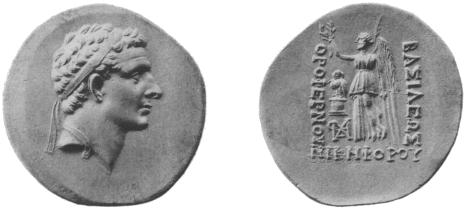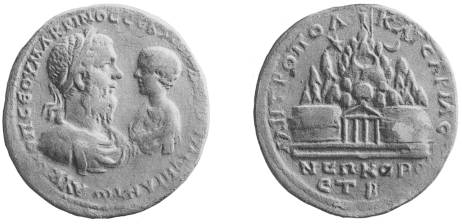
FIG. 330.



[Th. Reinach, Trois royaumes &c.; Wroth, B. M. C., Galatia, Cappadocia, &c.]
The Persian governors who ruled Cappadocia before the expedition of Alexander the Great do not appear to have struck coins, with the exception of the satrap Datames (circ. B.C. 362), in whose name money was issued at Sinope and at Gaziura in Pontus (see B. M. C., p. xxiv, and Regling in Z. f. N., xxiv (1904), p. 132). The continuous regal series begins with Ariarathes I, whose dynasty was succeeded, circ. B.C. 95, by that of Ariobarzanes I.
| Inscr. Baal-Gazur (Aramaic letters).
Baal of Gaziura seated, holding eagle,
vine-branch, and sceptre. [Waddington, Rec. gén., i, pp. 82 f.] |
Inscr. Ariorat (Aramaic letters). Griffin devouring stag. AR Drachm 87 grs. Struck at Gaziura (Ariarathes also struck drachms at Sinope with his name in Aramaic). |
Ariarathes II, B.C. 301-280 (?), son of Ariarathes I. Bronze coins (?) : see B. M. C., p. xxv.
Ariaramnes, B.C. 280 (?)-230 (?), son of Ariarathes II.
| Head of Ariaramnes in leather helmet. [B. M. C., p. xxv; cf. Hunter Cat., ii, p. 573.] |
ΑΡΙΑΡΑΜΝΟΥ Horseman galloping.
Berlin. Æ .8.
|
Ariarathes III, B.C. 240 (?)-220, son of Ariaramnes.
| Bust of Ariarathes III, diademed. | ΒΑΣΙΛΕΩΣ ΑΡΙΑΡΑΘΟΥ Athena seated, holding Nike. AR Tetr. Paris [B. M. C., p. xxvi]. |
| Bust of Ariarathes III, youthful, in helmet. | ΒΑΣΙΛΕΩΣ ΑΡΙΑΡΑΘΟΥ Athena seated, holding Nike. Æ. Paris [B. M. C., p. xxvi]. |
Ariarathes IV, Eusebes, B.C. 220-163, son of Ariarathes III.
| Head of Ariarathes IV. | ΒΑΣΙΛΕΩΣ ΑΡΙΑΡΑΘΟΥ ΕΥΣΕ- ΒΟΥΣ Athena standing, holding Nike. AR Tetr. Paris. Berlin [B. M. C., p. xxvii]. Also Drachms with dates (regnal years) 3, 30, 31, 33, Brit. Mus., &c. |
Ariarathes V, Eusebes, Philopator, B.C. 163-130, son of Ariarathes IV.
| Head of Ariarathes V. | ΒΑΣΙΛΕΩΣ ΑΡΙΑΡΑΘΟΥ ΕΥΣΕ- ΒΟΥΣ ΦΙΛΟΓΙΑΤΟΡΟΣ Athena standing, holding Nike. AR Tetradr. Brit. Mus. Another tetradr. without ΦΙΛΟΓΙΑΤΟΡΟΣ; and a third tetradr. with the inscr. ΒΑΣΙΛΕΩΣ ΑΡΙΑΡΑΘΟΥ ΑΡΙΑΡΑΘΟΥ ΦΙΛΟ- ΠΑΤΟΡΟΣ [B. M. C., p. xxviii]. |
| Head of Ariarathes V. | ΒΑΣΙΛΕΩΣ ΑΡΙΑΡΑΘΟΥ ΕΥΣΕ-
ΒΟΥΣ Athena standing, holding
Nike. Regnal years. AR Dr.
|

Orophernes, B.C. 158-157, pretender.
| Head of Orophernes (Fig. 330). [B. M. C., p. xxviii; p. 34; cf. Dressel in Sitzungsberichte der konigl. preus- sischen Akad. der Wissenschaften, xxiii. 1905, p. 467.] | ΒΑΣΙΛΕΩΣ ΟΡΟΦΕΡΝΟΥ ΝΙΚΗΦΟ- ΡΟΥ Nike standing, holding wreath and palm; in field, owl on basis (mint-mark of Priene). AR Tetradr. (Specimens have been found at Priene, where Orophernes deposited his trea- sure.) |
Ariarathes VI, Epiphanes, Philopator, B.C. 125 (?)-111 (?), son of Ariarathes V; Nysa, queen-regent.
| Heads of Nysa, the queen-regent, and her young son, Ariarathes VI. | ΒΑΣΙΛΙΣΣΗΣ ΝΥΣΗΣ ΚΑΙ ΒΑΣΙ- ΛΕΩΣ ΑΡΙΑΡΑΘΟΥ ΕΠΙΦΑΝΟΥΣ ΤΟΥ ΥΙΟΥ Athena seated, hold- ing Nike. AR Dr. Paris. [Reinach, Trois royaumes, p. 46, no. 14.] |
| Head of Ariarathes VI. | ΒΑΣΙΛΕΩΣ ΑΡΙΑΡΑΘΟΥ ΕΠΙΦΑ-
ΝΟΥΣ Athena standing, holding
Nike (with dates, years 1 to 15).
AR Dr.
|
Ariarathes VII, Philometor, B.C. 111 (?)-99 (?), eldest son of Aria- rathes VI, by Laodice, daughter of Mithradates V. Euergetes, King of Pontus.
| Head of Ariarathes VII. | ΒΑΣΙΛΕΩΣ ΑΡΙΑΡΑΘΟΥ ΦΙΛΟΜΗ-
ΤΟΡΟΣ Athena standing, holding
Nike. Regnal years. AR Dr.
|
Ariarathes VIII, B.C. 99-97 (?), second son of Ariarathes VI, by Laodice. Apparently struck no coins (B. M. C., p. xxx).
Ariarathes IX, Eusebes, Philopator, B.C. 99-87, son of Mithradates VI, Eupator, King of Pontus (B. M. C., p. xxx).
| Head of Ariarathes IX (struck at Am- phipolis in Macedonia (?)). | ΒΑΣΙΛΕΩΣ ΑΡΙΑΡΑΘΟΥ ΕΥΣΕ-
ΒΟΥΣ ΦΙΛΟΠΑΤΟΡΟΣ Pegasos,
drinking; in field, crescent and star
and mon.; whole in vine-wreath.
AR Tetradr.
|
| Id. | ΒΑΣΙΛΕΩΣ ΑΡΙΑΡΑΘΟΥ ΕΥΣΕ-
ΒΟΥΣ Athena standing, holding
Nike. Regnal years. AR Dr.
|
Ariobarzanes I, Philoromaios, B.C. 95-62.
| Head of Ariobarzanes I. | ΒΑΣΙΛΕΩΣ ΑΡΙΟΒΑΡΖΑΝΟΥ ΦΙ-
ΛΟΡΩΜΑΙΟΥ Athena standing,
holding Nike. Regnal years. AR Dr.
|
Ariobarzanes II, Philopator, B.C. 62-52, son of Ariobarzanes I.
| Head of Ariobarzanes II. | ΒΑΣΙΛΕΩΣ ΑΡΙΟΒΑΡΖΑΝΟΥ ΦΙ- ΛΟΠΑΤΟΡΟΣ Athena standing, holding Nike. AR Dr. (Some with regnal years.) |
Ariobarzanes III, Eusebes, Philoromaios. B.C. 52-42, son of Ario- barzanes II, by his wife Athenais Philostorgos II, a daughter of Mithra- dates Eupator, King of Pontus.
| Head of Ariobarzanes III. | ΒΑΣΙΛΕΩΣ ΑΡΙΟΒΑΡΖΑΝΟΥ ΕΥ-
ΣΕΒΟΥΣ ΚΑΙ ΦΙΛΟΡΩΜΑΙΟΥ
Athena standing, holding Nike; in
field, Pontic emblems of crescent and
star. Regnal years. AR Dr.
|
Ariarathes X, Eusebes, Philadelphos, B.C. 42-36, brother of Ario- barzanes III.
| Head of Ariarathes X. | ΒΑΣΙΛΕΩΣ ΑΡΙΑΡΑΘΟΥ ΕΥΣΕ-
ΒΟΥΣ ΚΑΙ ΦΙΛΑΔΕΛΦΟΥ Athena
standing, holding Nike. Regnal
years. AR Dr.
|
| Bust of Ariarathes X. | ΒΑΣΙΛΕ ΑΡΙΑΡΑΘΟΥ Bow in case.
Æ .65
|
| Bull. | ΒΑΣΙΛΕΩΣ ΑΡΙΑΡΑΘΟΥ Bow in case. Æ .65. [Imhoof, Kl. M., ii, p. 499.] |
Archelaus, Philopatris, Ktistes, reigned from B.C. 36 till his death in A. D. 17, when Cappadocia became a Roman province.
| Head of Archelaus (struck in island of Elaeusa; see B. M. C., p. xxxiii, quoting Imhoof). | ΒΑΣΙΛΕΩΣ ΑΡΧΕΛΑΟΥ ΦΙΛΟΓΙΑ-
ΤΡΙΔΟΣ ΤΟΥ ΚΤΙΣΤΟΥ Club.
Regnal years. AR Dr.
|
| Head of Herakles. [Rein. Tr. Boy., p. 67.] |
ΒΑΣΙΛΕΩΣ ΑΡΧΕΛΑΟΥ Mount Ar-
gaeus. Regnal years. AR Dr. or ½ Dr.
|
[B. M. C., Galatia, Cappadocia, &c.]
Caesareia, now Kaisariyeh, at the foot of Mount Argaeus. Its original name was Mazaca, and the place was the capital of the Cappadocian kings. It was renamed Eusebeia and finally called Caesareia. Autono- mous. The earliest coins are bronze of the time of Archelaus the last king (see supra), some inscribed ΕΥΣΕΒΕΙΑΣ and others inscribed ΚΑΙΣΑ- ΡΕΙΑΣ. From the dates on these it appears that the town changed its name from Eusebeia to Caesareia at some time between B.C. 12 and B.C. 9 (Imhoof, Zur griech. Münzkunde, 1898, pp. 3 f.; B. M. C., pp. xxxiv f.). Types—Mount Argaeus; Bust of Athena; Statue of Asiatic goddess; Head of Herakles; &c. (Imhoof, loc. cit.).
Imperial, Tiberius to Treb. Gallus. The coins—AR and Æ—were struck in large numbers, as Caesareia, like Antiocheia in Syria, was an Imperial mint for the East. The normal weights of the silver seem to be Tridrachm, 180 grains; Didr., 120 grs.; Dr., 60 grs.; ½ Dr., 30 grs. After the time of Severus the AR becomes debased. Both AR and Æ bear dates of the Emperors’ reigns, and the AR records the consulate, e.g. ΥΠΑΤΟC Γ (= COS III), and the tribunician power, ΔΗΜΑΡΧΙΚ(ης) ЄΞΟΥC(ιας).
Inscr., ΚΑΙCΑΡЄWΝ ΤWΝ ΠΡΟC ΤW ΑΡΓΑΙW and abbrev.; ΜΗΤΡΟΠΟΛЄΩC ΚΑΙCΑΡΙΑC; ΜΗΤΡΟΠΟΛЄΙΤΩΝ (Hunter Cat., ii. Pl. LXII. 24); sometimes with ЄΝΤΙΧΙΟΝ (εντειχιον χωριον) added (B. M. C., p. xxxv), also with ΝЄΩΚΟΡΟΥ.
Types—With the exception of Mount Argaeus, which occurs very frequently, the types are generally not of local significance, but are copied from Roman coins (see B. M. C., pp. 46 ff.), e. g. ЄΛЄΥΘ(ερια) ΔΗΜΟΥ = Libertas publica, Liberty standing (R. N., 1895, p. 68); ΠΡΟΝΟΙΑ, Provi- dentia standing. There are also Æ coins with rev. Stone of pyramidal form (=Argaeus ?) attributed to Caesareia (B. M. C., p. xxxix n.). Argaeus is shown as a cavernous, peaked mountain, and is often surmounted by a star. Sometimes a male figure (a god, or the deified Emperor?)

viii. 8), [Argaeus] οροσ Kαππαδοκαισ και θεοσ και ορκοσ και αγαλμα, and see on the Argaeus types, B. M. C., pp. xxxviii f., and Rossbach, Neue Jahrb., vii. pp. 406-9. A specimen at Berlin (Journ. Int., 1898, pp. 455 f.) shows Argaeus, and a temple inscribed ЄΙCЄΩΝΑ(αιωνα)ΤΟΥC ΚΥΡΙΟΥ[C], i. e. ‘long life to the Emperors’. Another coin (B. M. C., Pl. XIII. 2; cf. Hunter Cat., ii. p. 593, No. 82; also Imhoof, Zur gr. u. röm. Münzk., p. 231) shows two columns or towers, enclosed within a palisade, beside the mountain. The Tyche of the city sometimes wears Argaeus as a head-dress (Z. f. N., xxiv. p. 86).
Magistrates, Πρεσβευτης, i.e. the legatus Augusti pro praetore of Galatia and Cappadocia. Stephanephoroi sometimes occur (Imhoof, Zur gr. u. röm. Münzk., p. 232).
Games, ΦΙΛΑΔЄΛΦ(ЄΙΑ) (B. M. C., p. 82, No. 280).
Alliance with Smyrna—Sept. Severus and Domna.
Comana (Sherherdere-si), famous for its sanctuary of the goddess Mâ. No coins can be attributed to this place; cf. B. M. C., p. xli; Rev. des études gr., xii. (1899), p. 102., and Comana in Pontus, supra, p. 498.
Cybistra (Eregli). Æ of the time of Trajan. Inscr., ΚΥΒΙCΤΡЄWΝ. Rev. types—Harpa; River-god swimming. Magistrate, Name of the legatus P. C. Ruso (B. M. C., p. xli; p. 95).
Eusebeia. See Caesareia.
Tyana, now Kiz (or Kilisa) Hissar. Æ of a Cappadocian dynast ΑΡΙ... (Ariaos ?) were struck here, circ. B.C. 280 (?). Obv. Beardless head in Cappadocian tiara, rev. Horse galloping; in front, a palm-tree; beneath., ΑΡΙ ΔΣ ΤΥ. Berlin (Dressel in Z. f. N., xxi. (1898), p. 227). Another variety has rev. Horseman with javelin, ΣΔ and ΤΥΑΝ. (Invent. Wadd., No. 6800).
Imperial, Trajan to Caracalla. Inscr., ΤVΑΝЄWΝ; ΤVΑΝЄWΝ Τ. Π. Τ. (= ΤΩΝ ΠΡΟC ΤΑΥΡΩ) ΙЄΡΑC Κ. ΑCVΛΟV Κ. ΑVΤΟΝΟΜΟ. Under Domna and Caracalla the inscription is ΑΝΤ. ΚΟΛΩΝΙΑ ΤVΑΝΩΝ or ΑVΡ. ΚΟΛΩΝΙΑC ΤVΑΝΩΝ, the colony taking these names, ‘Αντωνινιανη Αυρηλια, in honour of Caracalla (Imhoof, Kl. M., p. 499). Types—Tyche of city seated holding corn and grapes; Perseus; Athena; Asklepios, Humped bull and two vexilla. Dates, Regnal years of the Emperors.